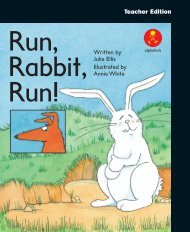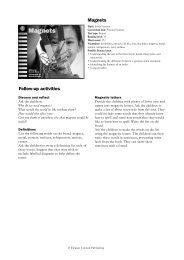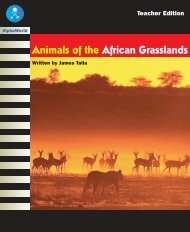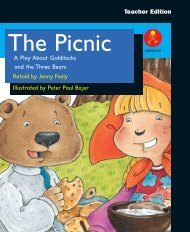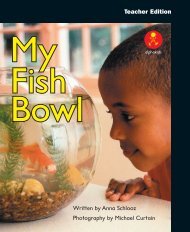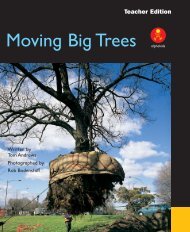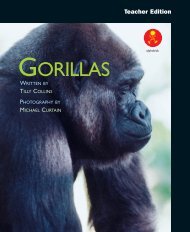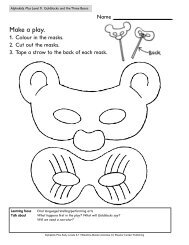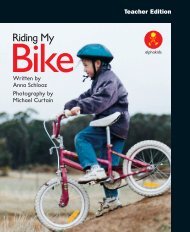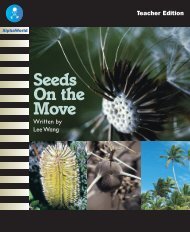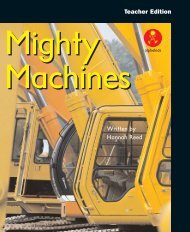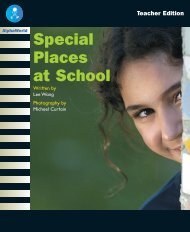L16 TEpp Crabs
L16 TEpp Crabs
L16 TEpp Crabs
Create successful ePaper yourself
Turn your PDF publications into a flip-book with our unique Google optimized e-Paper software.
Teacher Edition<br />
<strong>Crabs</strong><br />
Written by Marilyn Woolley<br />
alphakids
Horwitz Education<br />
A Division of Horwitz<br />
Publications Pty Ltd<br />
55 Chandos Street<br />
St Leonards NSW 2065<br />
Australia<br />
Horwitz Gardner<br />
Education<br />
Unit 53, Cressex<br />
Enterprise Park<br />
Lincoln Road<br />
High Wycombe,<br />
Bucks, HP12 3RL,<br />
United Kingdom<br />
Published edition<br />
© Eleanor Curtain<br />
Publishing 2003<br />
First published 2003<br />
Apart from any fair dealing for<br />
the purposes of study, research,<br />
criticism or review, as<br />
permitted under the Copyright<br />
Act of Australia, no part of this<br />
book may be reproduced by<br />
any process, or transmitted in<br />
any form, without permission<br />
of the copyright owner. Where<br />
copies of part or the whole of<br />
this book are made under Part<br />
VB of the Copyright Act, the<br />
law requires that records of<br />
such copying be kept and the<br />
copyright owner is entitled to<br />
claim payment.<br />
Developed by<br />
Eleanor Curtain Publishing<br />
Text: Jenny Feely<br />
Consultant: Susan Hill<br />
Designed by<br />
Alexander Stitt<br />
Production by<br />
Publishing Solutions<br />
Printed in Hong Kong<br />
ISBN 0 7253 2843 6<br />
Pack ISBN 0 7253 2799 5<br />
(6 Student Books + 1 Teacher<br />
Edition)<br />
1 2 3 4 5 6 7 8 9<br />
03 04 05<br />
<br />
How to use this book<br />
Before reading: Talkthrough<br />
Talk through the book with the children. Encourage<br />
them to predict the text from the cover and the<br />
pictures, and to think about the information they<br />
provide. Direct the children’s attention to aspects of<br />
the text that may challenge them. Support the children<br />
to deal with these challenges by asking the<br />
Talkthrough questions on each page.<br />
During reading: Observe and support<br />
Observe the children as they read. Encourage them to<br />
monitor their own reading as they comprehend the<br />
text. As needed, support children by assisting them to<br />
discover and use reading strategies and cues to solve<br />
problems and respond to reading challenges that arise<br />
in the text. Interruptions to the child’s reading should<br />
be minimal and focused on a specified learning need.<br />
After reading: Comprehension, returning to<br />
the text, responding and writing links<br />
To further develop children’s understanding of the<br />
text, select from activities found on page 12 and the<br />
inside back cover. These whole text, sentence and word<br />
level activities reinforce the teaching focus of this<br />
book. Assessment ideas are provided to assist with<br />
planning for further teaching.<br />
Text highlights<br />
• Colour photographs provide information<br />
about the diversity of crabs<br />
• A table of contents is provided<br />
Vocabulary<br />
crabs, animals, seashore, food, enemies, rock<br />
pools, low tide, coral reefs, mud, seaweed,<br />
nippers, mouths, shell, hermit crab, sideways,<br />
backwards, flippers
Setting the context<br />
Ask: What do you know about<br />
crabs What would you like to<br />
find out<br />
Record the children’s ideas<br />
on a chart.<br />
Background information<br />
<strong>Crabs</strong> are crustaceans that<br />
have ten legs. Most crabs<br />
live in or near water, but<br />
some crabs live all of their<br />
lives on the land returning<br />
to the water only to lay eggs.<br />
Introducing the book<br />
This book is called ‘<strong>Crabs</strong>’. It<br />
tells us information about<br />
where crabs live, what they<br />
eat, what they look like, how<br />
they move and how they<br />
protect themselves.<br />
<strong>Crabs</strong><br />
Written by Marilyn Woolley<br />
alphakids<br />
<strong>Crabs</strong><br />
Written by Marilyn Woolley<br />
alphakids<br />
Front cover<br />
What is this How many legs does it have<br />
Where are its eyes What is its body covered<br />
in<br />
What is it doing<br />
Title page<br />
Point out the name of the author, the<br />
photographer and the logo.<br />
What do you notice about these crabs<br />
What are they doing
<strong>Crabs</strong> Pages 2–5<br />
<br />
Talkthrough<br />
Refer to the table of contents.<br />
This is the contents page. The contents page tells us where<br />
we can find different information in the book. What page<br />
would you look at to learn about what crabs eat<br />
Point out that a contents page helps you to choose where<br />
to start reading a book, and that you don’t have to read<br />
from the front to the back.<br />
Look at page 4.<br />
What is this section called How did you know that it was<br />
the heading What does the introduction tell us<br />
Observe and support<br />
Is the child able to point out different text features on the<br />
page<br />
Where is the heading How did you know that it was a<br />
heading<br />
2
Contents<br />
Introduction 4<br />
Where crabs live 6<br />
What crabs eat 8<br />
What crabs look like 10<br />
How crabs move 12<br />
How crabs protect themselves 16<br />
Introduction<br />
<strong>Crabs</strong> are animals.<br />
They are found around the seashore.<br />
<strong>Crabs</strong> move in different ways to find<br />
their food and to hide from their enemies.<br />
4<br />
5<br />
3
<strong>Crabs</strong> Pages 6–9<br />
<br />
Talkthrough<br />
What is this section called It tells us about where crabs live.<br />
Some live in rock pools, some live around coral reefs and<br />
some live in mud. If you were looking for the word ‘coral’<br />
what would you look for What letters would you expect to<br />
see<br />
Look at pages 8–9.<br />
This section tells us about what crabs eat. What do you think<br />
they eat<br />
Can you see the crab’s mouth It has lots of parts.<br />
(Note: the crab’s mouth parts are near the large nippers.)<br />
Observe and support<br />
Can the child use the text to interpret the information<br />
contained in the photographs<br />
What do crabs use to get food How do they do it<br />
4
Where crabs live<br />
Most crabs live in rock pools<br />
or on the seashore at low tide.<br />
Some crabs live around coral reefs.<br />
Some crabs live in mud.<br />
6<br />
7<br />
What crabs eat<br />
<strong>Crabs</strong> eat seaweed, tiny sea animals<br />
and any dead things they find.<br />
<strong>Crabs</strong> use their sharp nippers<br />
to grab hold of the food they eat.<br />
Their mouths have many moving parts.<br />
8 9<br />
5
<strong>Crabs</strong> Pages 10–11<br />
<br />
Talkthrough<br />
Look at page 10.<br />
What grows on the outside of the crab Would it be hard or<br />
soft Would a hard shell stretch as the crab grows One kind<br />
of crab doesn’t have a hard shell. It is called a hermit crab.<br />
It finds old shells and lives in them. Can you find the words<br />
‘hermit crab’ on page 11 How did you find the words<br />
What did you look for<br />
(Both crabs on page 11 are hermit crabs.)<br />
Observe and support<br />
Can the child use their understanding of phonics to work<br />
out new words such as ‘hermit crab’<br />
Can you break up the word Which part of the word makes<br />
the /cr/ sound What sound do the letters /er/ make in the<br />
word<br />
6
What crabs look like<br />
<strong>Crabs</strong> have a hard shell on the outside<br />
of their bodies. As crabs grow bigger<br />
they become too big for their shells.<br />
They grow a new shell under their<br />
old shell. Then the old shell falls off.<br />
The hermit crab is the only crab<br />
that does not have a shell.<br />
It finds an empty shell to live in.<br />
10<br />
11<br />
7
<strong>Crabs</strong> Pages 12–15<br />
<br />
Talkthrough<br />
Read page 12. Point out the word ‘most’ on the page.<br />
What does ‘most’ mean Does it apply to all crabs The<br />
book says that most crabs move sideways. How would they<br />
do that How else might crabs move<br />
Point out the crabs on page 14.<br />
These crabs move forwards.<br />
Look at the photograph on page 15.<br />
Look at the back legs on this crab. Why are they so much<br />
longer than its other legs For what purpose might it use<br />
these legs<br />
Observe and support<br />
Can the child understand the literal meaning of the text<br />
How do crabs move Where does the book tell you this<br />
If the child has difficulty ask them to re-read the text and<br />
look for words to do with moving.<br />
8
How crabs move<br />
Most crabs move sideways when they walk.<br />
The legs on one side of their bodies<br />
pull them along.<br />
The legs on the other side push them along.<br />
Some crabs can also move backwards<br />
to hide from their enemies.<br />
12<br />
13<br />
Some crabs move forward with their legs<br />
held up off the sand or mud.<br />
These crabs often march<br />
in very large groups.<br />
Some crabs can swim quickly<br />
under water. They have flippers on<br />
the backs of their bodies.<br />
14<br />
15<br />
9
<strong>Crabs</strong> Page 16<br />
<br />
Talkthrough<br />
How might crabs protect themselves What things can they<br />
do<br />
Point out that a crab’s hard shell makes it difficult for<br />
other animals to hurt it.<br />
Why would a crab need to protect itself<br />
Which animals might be a crab’s enemies<br />
Observe and support<br />
Can the child read the text fluently<br />
Model reading a passage of the text to the child. Have the<br />
child read it with you.<br />
Can you make it sound like I do<br />
Have the child read the text by themselves.<br />
10
How crabs protect themselves<br />
When crabs see an enemy<br />
they can move quickly to hide.<br />
Their hard shells save them<br />
from their enemies.<br />
16<br />
11
<strong>Crabs</strong><br />
Being a meaning maker<br />
Encourage the children to support<br />
their answers with evidence from the<br />
book as they discuss these questions:<br />
What do crabs eat<br />
How is a crab’s mouth like yours How<br />
is it different<br />
How does a crab protect itself from<br />
enemies<br />
What dangers might a crab face<br />
Being a code breaker<br />
Children may like to explore the<br />
following language features:<br />
• Classifying language: some, most.<br />
• Language used to refer to groups:<br />
these, they, some crabs, most crabs,<br />
their, they.<br />
Being a text user<br />
Refer to the chart that children made<br />
in the ‘Setting the context’ section on<br />
page 1.<br />
What did you learn about crabs in this<br />
book<br />
Which of our questions were answered<br />
Which were not<br />
Discuss any contradictions between<br />
any prior knowledge children had<br />
about crabs with the information in<br />
the book.<br />
Being a text critic<br />
What things about crabs has the author<br />
included in the book<br />
What things has the author left out<br />
What would you have added if you were<br />
the author<br />
What would you have left out<br />
Does this author know what children<br />
are interested in<br />
12
Responding to text<br />
Children could each make a<br />
cardboard crab and attach it to<br />
a stick with a piece of string. These<br />
could be used to make a documentary<br />
video about crabs.<br />
Children could make a poster of<br />
a crab using labels to provide<br />
specific information, e.g., ‘This is a<br />
crab’s shell. It doesn’t get bigger.<br />
When the crab gets bigger it has to<br />
grow a new shell underneath the old<br />
shell. Then the old shell falls off.’<br />
Children could brainstorm a<br />
range of words about crabs.<br />
These could be sorted into groups<br />
according to the children’s own<br />
criteria, e.g., names of parts,<br />
movement words, describing words.<br />
Writing links<br />
Shared/guided writing<br />
List the headings from the book on<br />
the board.<br />
What information can we put under<br />
each heading<br />
List children’s suggestions under each<br />
heading in point form. Share in<br />
writing a section for a book about<br />
crabs.<br />
Independent writing<br />
Children could use the headings in<br />
the book to write a similar book about<br />
a different animal. Children could<br />
write one section each and then<br />
combine the sections to make a class<br />
book.<br />
Assessment<br />
Can the child:<br />
• Explain the use of text features, such as a table of contents or headings<br />
• Explain what all crabs need to stay alive<br />
• Say how their prior knowledge about crabs differs to the information in the<br />
book<br />
whole text activity sentence activity word activity
<strong>Crabs</strong><br />
Written by Marilyn Woolley<br />
alphakids<br />
Teacher<br />
Edition<br />
Other books<br />
at this level<br />
Animals<br />
That<br />
Sting<br />
alphakids<br />
Written by Claire Saxby<br />
Photography by Gary Lewis<br />
Topic: Animals<br />
Curriculum link: Science<br />
Text type: Report<br />
Reading level: 16<br />
Word count: 232<br />
Vocabulary: crabs, animals, seashore, food,<br />
enemies, rock pools, low tide, coral reefs, mud,<br />
seaweed, nippers, mouths, shell, hermit crab,<br />
sideways, backwards, flippers<br />
Possible literacy focus<br />
Using features of a non-fiction text to support<br />
understanding.<br />
Drawing inferences about the needs of all crabs.<br />
Summary<br />
This book provides information about where<br />
crabs live, how they move and eat, what they look<br />
like and how they protect themselves.<br />
Skate<br />
Racer<br />
Written by<br />
Hannah Reed<br />
Photography by<br />
Michael Curtain<br />
The Three Wishes<br />
Retold by Sara Oldfield<br />
Illustrated by Alex Stitt<br />
alphakids<br />
alphakids<br />
Seashore<br />
Plants<br />
Written by Marilyn Woolley<br />
Photography by Jason Edwards<br />
Stop<br />
That<br />
Dog!<br />
Written by Sue Whiting<br />
Illustrated by Chantal Stewart<br />
alphakids<br />
alphakids<br />
ISBN 0- 7253- 2843- 6<br />
9 780725 328436<br />
alphakids



